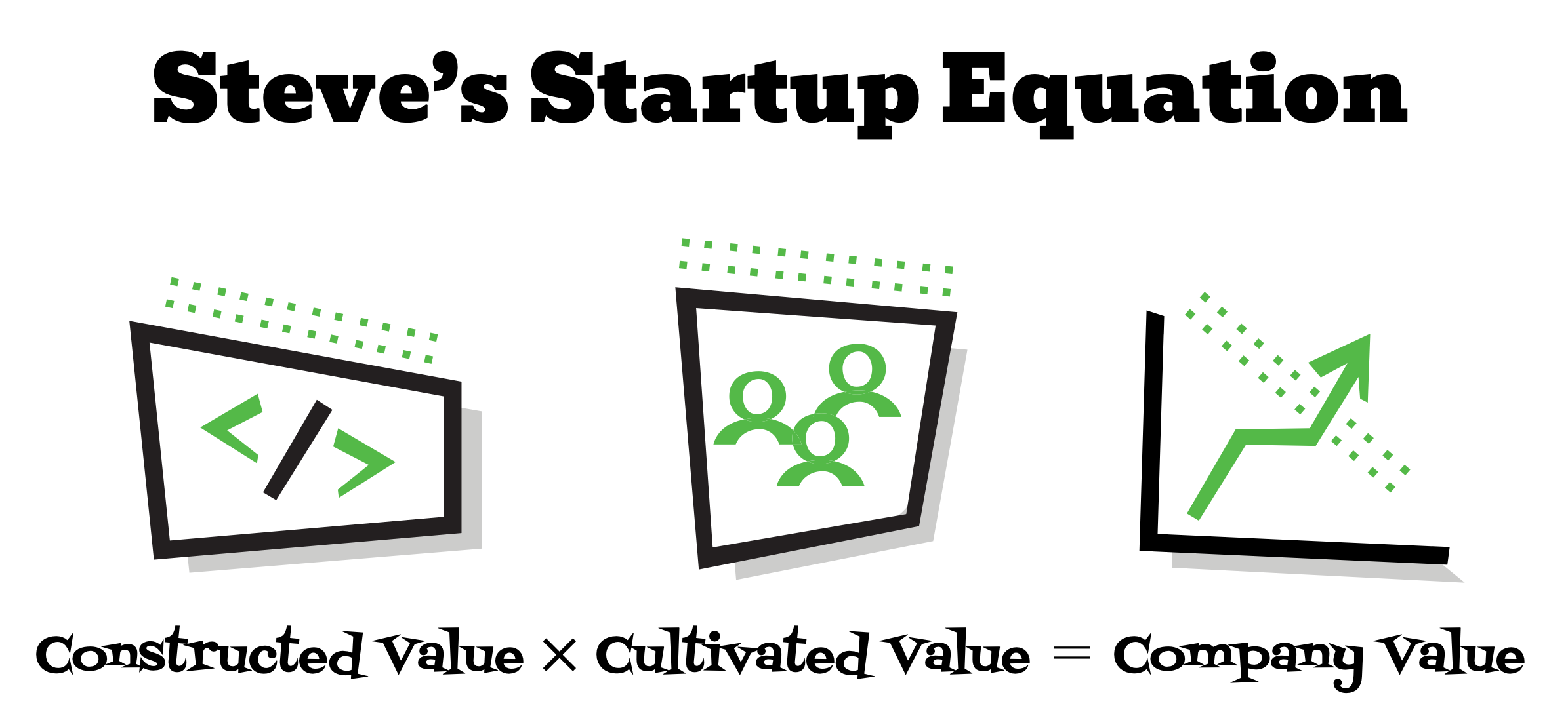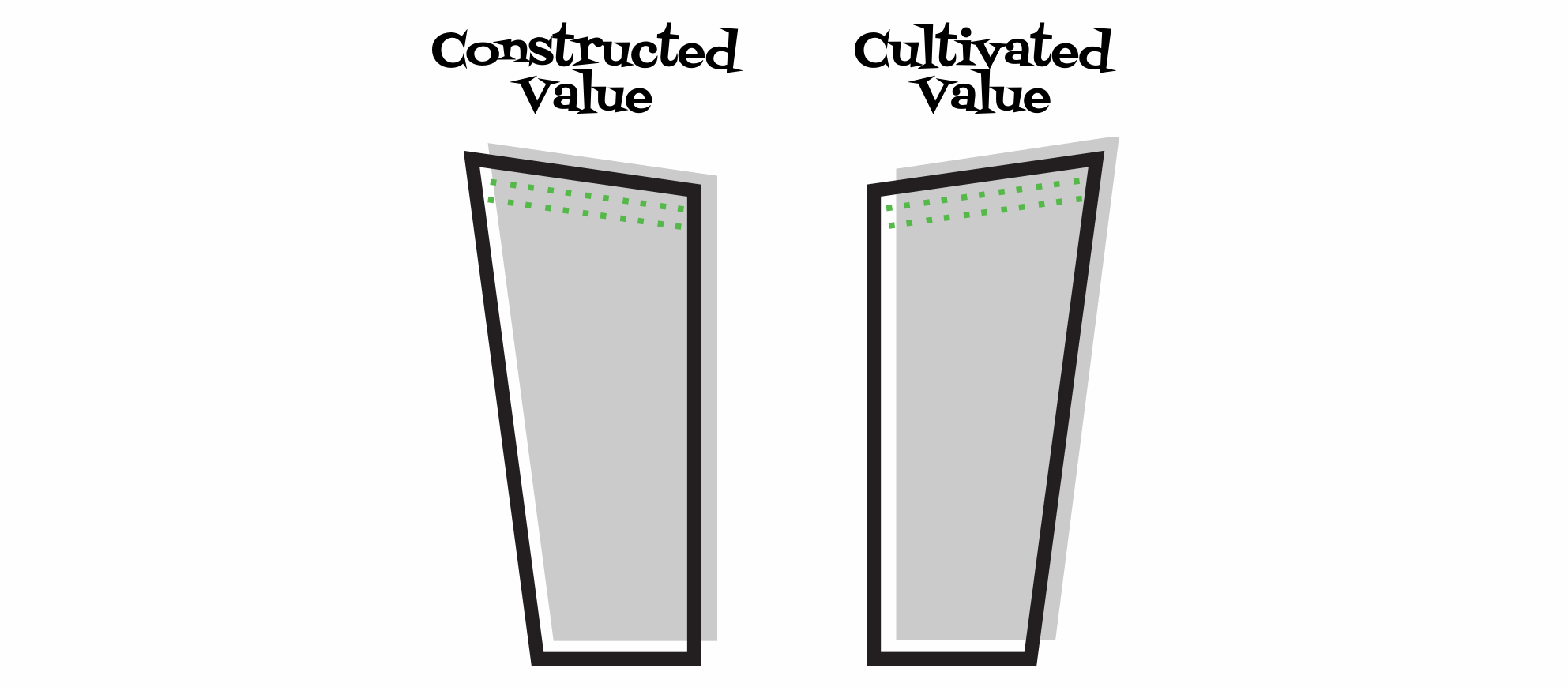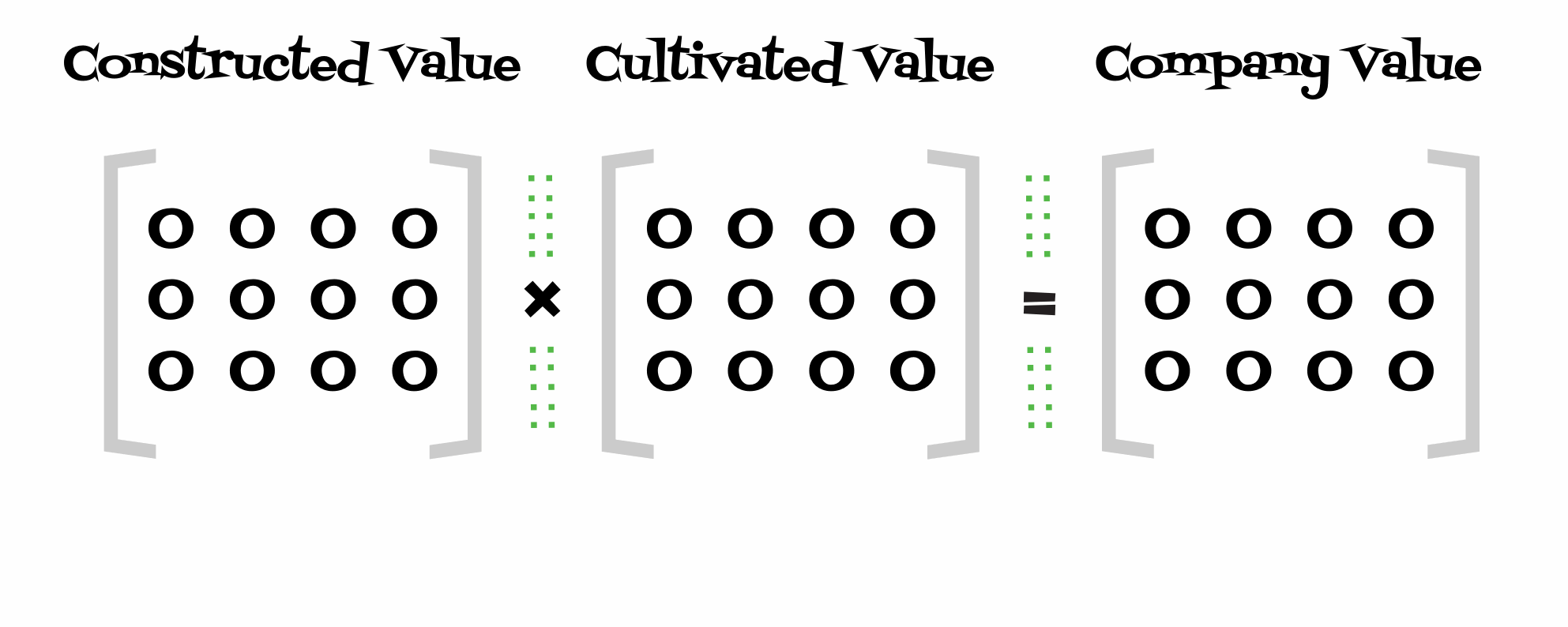Steve's Startup Equation
If a product is created in the forest, but no one is there to use it, does it create value?
Through my experience building startups, one of the hardest things to do is to figure out what to work on at any given time. This is true day to day and year to year. I’ve developed an equation that helps me conceptualize the universe of options and facilitate discussions with my team. For a long time, I called it “Steve’s Startup Equation” as a placeholder until I could figure out a better name. Years later, I still haven’t gotten around to coming up with something better. To hell with it. In its basic form, it looks like this:
First, some definitions.
Constructed Value: the thing you’re building or creating. It has the potential to provide value to someone if only they’d use it. I like the word, “constructed”, because it has two very different meanings, both of which apply. As a verb, it’s the tangible product you’re constructing, creating, building. As a noun, it’s a construct, or a working hypothesis as to what you believe will provide value, which must then be validated by users.
Cultivated Value: the users or customers who use or purchase the thing you’ve built to realize the constructed value potential. Just as you can cultivate land before planting crops, and also cultivate already-planted crops to grow, so too can cultivated value come before and/or after constructing the product.
Company Value: the long-term, sustainable value of the startup or company.
The “long-term sustainable” qualifier is important, because there are many possibilities that fall outside this goal for a startup. You could build unsustainably and inflate your startup’s perceived value. You could even carry this unsustainable, perceived value through acquisition or IPO and let the reckoning of reality become someone else’s problem. I think such startups are likely too complicated with many more moving parts for this equation to apply.
There is also significance to the use of multiplication, and that is for both its commutative property and zero property.
Commutative Property
It’s generally advised in Lean Startup methodology to do customer development (i.e. cultivate value) before building anything. This can be great advice, but I don’t think it’s absolute. It depends on several assumptions, and I’ve found the opposite can also work. You can cultivate value before constructing value (conventional Lean Startup wisdom), or you can construct value before cultivating value. We’ll talk more about that later.
Zero Property
The other key characteristic is that anything multiplied by zero is zero. This means that if you’ve built something with no users, it’s not worth anything to the Company Value. Likewise, if you’ve lined up customers for something you haven’t built, it’s also not worth anything to the Company Value. You’ve got either Constructed Value or Cultivated Value multiplied by zero.
Early-stage Startups
Putting the equation into practice first requires recognizing the stage of the startup. In the early stages, we are most limited in our resources of time and money. We can’t do everything, so we need to focus our efforts on those things which are most impactful toward our goals of long-term, sustainable value. In fact, we often can’t consistently construct value and cultivate value for any given feature concurrently, and must do them sequentially.
And so, in our first expansion of the equation, I envision each parameter as a one-dimensional meter, like a fuel gauge.
The entire process of building an early-stage startup consists of ratcheting up Constructed Value and Cultivated Value in lock-step. We may start with the results of the customer discovery process first (Cultivated Value), and then build the product based on the feedback we’ve received (Constructed Value). Or, we may build a proof-of-concept first (Constructed Value) to get into customers’ hands (Cultivated Value). The point is to keep ratcheting up both without getting too lopsided.
I’ve seen startups, especially those with technical founders, get too lopsided with Constructed Value, never feeling it’s ready to launch or put into the hands of customers, never actualizing the potential they’ve created and eventually flaming out when the founder has no more ability to continue on without traction. There are some famous examples of good technology with poor customer development, such as Aereo and Better Place. You may not remember these, which illustrates the point.
I’ve also seen startups get too lopsided with Realized Value, getting investors and customers/users to “realize” value that was never created. In recent years, think Theranos or WeWork.
You could think of these meters as towers whose stability is tethered to each other. Build one too high above the other, and it topples.
Start with Cultivation
We were relentless with customer development in my startup, Carcode, which we bootstrapped to acquisition by Edmunds.com in 2014. For cash-strapped startups on a mission, it typically makes sense to do customer development first. Given the cost of building a product, you want to ensure that you build the right thing. This isn’t a novel insight, and so I won’t belabor this strategy.
I think it’s also true that most founders err too often toward the build-first strategy, which explains why the prevalent advice is to counter this tendency.
However, the treating this advice as a panacea does a disservice to those in scenarios where it can make sense to build something first.
Start with Construction
There are two scenarios I’ve seen where building first can make sense. Both involve having the requisite resources and appropriate risk tolerance.
This first scenario is when building some product or feature significantly shortcuts the sales and customer discovery process. There are some things which are much easier understood when seen or experienced. If it would only take a couple weeks to build a proof-of-concept or some new feature, which when shown to customers would bypass a lot of discussion and get them to the “aha” moment faster, then it could be more efficacious to build it first, avoiding a lot of ineffective back-and-forth in the sales cycle.
This can be a slippery slope, though; I think founders, especially technical founders, overestimate the extent to which this may be true. Often, all that is needed is a few hours to develop better messaging or figuring out how to reframe the conversation (a topic I’m sure I’ll revisit in another post).
The second scenario is when you simply want to build it first and have the means. Do you have the ability to build it yourself and want to see if you can? Do it. Is it a labor of love? Go for it. Are you a student with a safety net, and have the luxury of being able to build something just because it’s fun? Take advantage! Do you have this gnawing feeling that you’re onto something, but you can’t seem to convey your vision to others? Maybe you need more customer discovery to refine your vision… or maybe you could build a simple version to show.
Some of the most interesting startups I’ve worked with (like EEme acquired by Tendril in 2019), and even founded (like Genomenon), were university spin-outs. And university spinouts are almost exclusively build-first startups. Tech Transfer programs are full of interesting technologies looking for a use-case.
The point isn’t that you should build first, but rather that it can work.
Later-stage Companies
As a startup grows and progresses beyond the Minimum Viable Product, the unidimensional meter metaphor loses its utility. Larger companies are much too complicated to model with a silly, one-dimensional metaphor. Which is why we need to make it sillier, by adding a second dimension.
In the later stages of a startup, as the company has grown, so too has your ability to do many things concurrently. You might think this removes one of the constraints that makes Steve’s Startup Equation useful, but in fact, this is the stage that inspired its creation. For larger companies entering the growth stage, I envision the equation as a Matrix Algebra problem:
In this representation, the X and Y coordinates of the matrices are meaningless (though they needn’t be); each position represents some new feature in the product, or some new product in the company’s portfolio (we’ll talk about minimum viable feature in another post). The implication is that the Company Value contributed by any given feature or product is a result of its Constructed Value multiplied by its Cultivated Value.
For simplicity, we can make this binary, as in the feature is built or it’s not, and a customer is using the feature or they’re not. Company Value for some feature or product increments when you have a 1 in both of the corresponding positions of Constructed Value and Cultivated Value.
As the company grows, the engineering team can build a proof of concept for Feature X, while the sales team is getting customer feedback for Feature Y. And then they can switch. The trick is to not end up with too many 1’s in one matrix without corresponding 1’s in the other. This helps us see if we’re spending too much time building without validating, or conversely promising too much without delivering.
Had Enough of the Metaphor, or You Thirsty for More?
If you thought the Matrix Algebra was a step too far, then hold onto your butts for this section, because we’re going plaid. (That’s two film references in two consecutive sentences, we seem to be jumping the shark. Oh no, that’s three!)
You could consider a startup’s market size to be the total value of the company when the theoretical Company Value matrix is all 1’s. In other words, when the Company Value matrix is all 1’s, that means the company has fully leveraged all of its conceivable revenue streams in its business model by fully building out and deploying all of its products into the market (though there’d be a third dimension representing market share for each product).
So then, assuming a late-stage company has nearly filled all of its matrices with 1’s, meaning it’s built and sold nearly every conceivable product and feature within its business model, where does it go from there? Why, horizontal or vertical expansion, of course! This would be expanding the size of the matrices horizontally and/or vertically.
That’s as far as I’ve found it useful to take this metaphor, so we’ll stop there.
I’d like to give a special thanks to Kevin Ryan, our Creative Director at Alfa Jango, for helping me come up with the logo for this blog and the graphics for this post based on the ambiguous direction of “retro fun”. I’d also like to thank John Hoinville, our Director of Operations, for reviewing this post and providing helpful suggestions.









